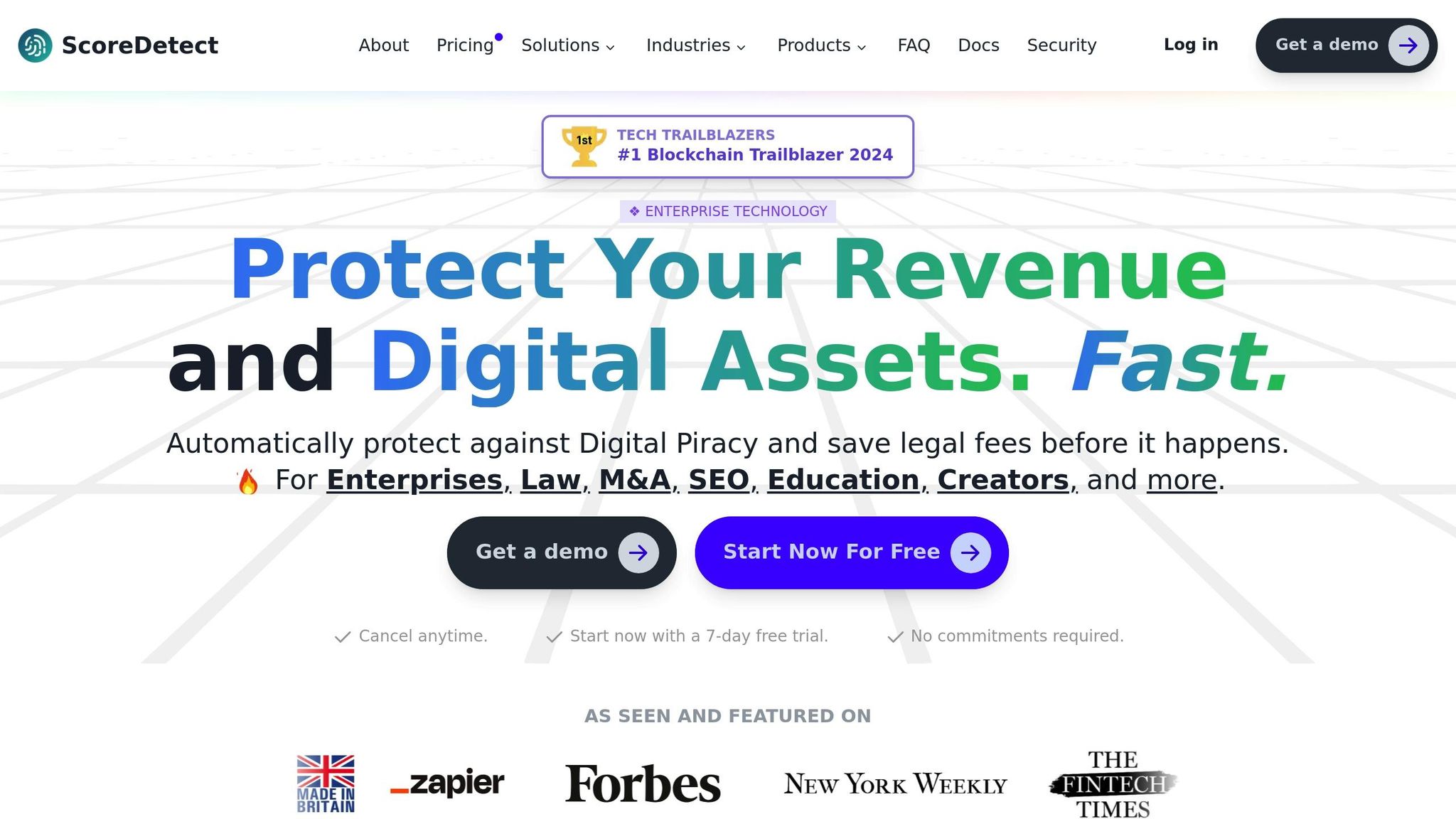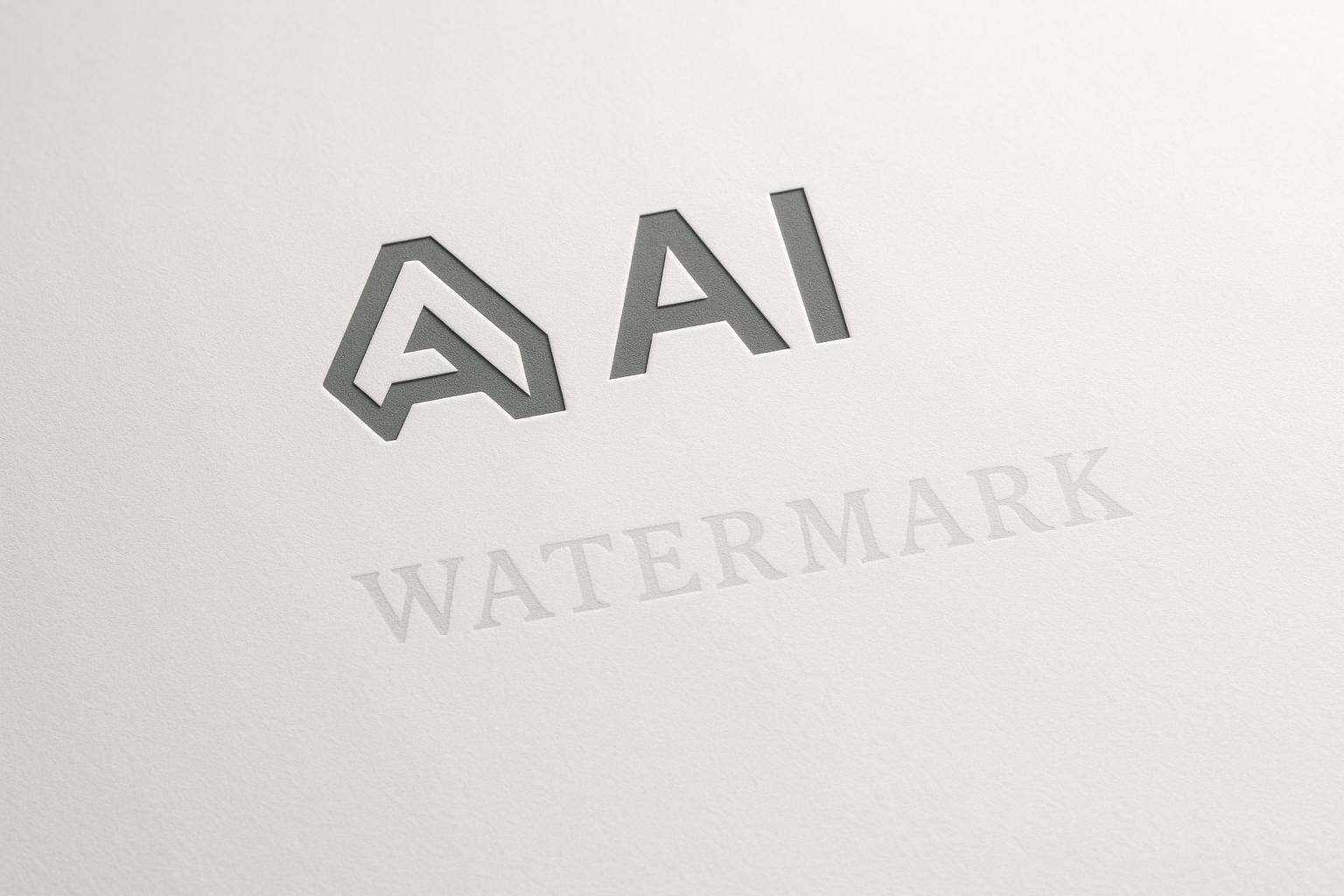Watermarking is a powerful way to fight digital piracy. It embeds hidden, traceable markers into content like videos, images, or documents, helping businesses protect their intellectual property without affecting user experience. These invisible markers can:
- Track the source of pirated content.
- Serve as legal evidence in copyright disputes.
- Preserve content quality while securing ownership.
With piracy causing billions in losses annually, industries like media, education, and healthcare are turning to watermarking to secure their assets. Tools like ScoreDetect combine watermarking with blockchain and AI to monitor and protect content effectively. This approach ensures businesses can safeguard their creations in a piracy-heavy digital world.
Forensic Watermarking for Video Protection | How It Works & Why It’s Essential
How Invisible Watermarking Works
Invisible watermarking embeds hidden digital markers into content during its creation. By using a watermark-embedding algorithm, unique, invisible identifiers are seamlessly integrated into media. A detection algorithm then identifies these markers in any distributed copies. This technology works across various formats like video, audio, images, and documents, offering features that set it apart from visible watermarking.
"AI watermarking involves embedding markers into multimedia content for it to be accurately identified as AI-generated." [1] – Alessandra Sala, Senior Director of AI and Data Science, Shutterstock
In the case of AI-generated content, these watermarks are added during model training, ensuring every output includes a distinct, traceable signature.
Key Features of Invisible Watermarking
- Embeds a unique, traceable signature into each piece of content, which is crucial for verifying its origin [1].
- Applied at the moment of content creation, acting as built-in proof of authenticity.
- Can integrate with blockchain technology to enable secure and tamper-proof provenance tracking [1].
Invisible vs. Visible Watermarking Comparison
The unobtrusive nature of invisible watermarking makes it an effective way to protect content while maintaining its original quality. Here’s how it compares to visible watermarking:
| Feature | Invisible Watermarking | Visible Watermarking |
|---|---|---|
| User Experience | Maintains the original quality of content | Can alter or distract from the content’s appearance |
| Piracy Deterrent | Hidden markers are harder to target | Visible marks can be easier to remove |
| Legal Evidence | Provides clear, detectable proof of origin | Proof may weaken if marks are removed |
| Content Integrity | Keeps the content’s authentic look | Alters the visual presentation |
Invisible watermarking offers a professional, unobtrusive way to protect content, ensuring it remains visually untouched for legitimate users while still providing a reliable method for tracking and verifying ownership.
Benefits of Watermarking for Digital Piracy Prevention
Watermarking plays a key role in helping creators maintain control over their work while also strengthening legal measures against piracy. By embedding invisible yet powerful markers into digital files, watermarking ensures protection without compromising user experience.
Traceability and Source Identification
Invisible watermarking is a game-changer when it comes to tracking digital assets. It embeds unique tracking data – such as user IDs, transaction details, and timestamps – directly into files like videos, images, and documents. This allows businesses to trace pirated content back to its source with precision. Specialized forensic tools can extract these details, making it easier to identify the origin of unauthorized copies.
Moreover, the mere presence of invisible watermarks often acts as a deterrent against unauthorized sharing [2]. For example, ScoreDetect employs this technology to embed undetectable markers into digital assets, ensuring full traceability across various distribution platforms while preventing illegal use.
This ability to trace content not only discourages piracy but also provides a solid foundation for legal action, as explained below.
Legal Protection and Evidence
Watermarked content is a powerful tool in legal battles, as it serves as admissible evidence in U.S. courts. This makes watermarking an essential component of copyright enforcement.
"Watermarked content serves as concrete evidence in legal actions against entities involved in distributing illegal content, strengthening the enforcement of copyright laws."
– Bytescare.com [3]
By presenting watermarked files in court, content owners can demonstrate their proactive efforts to protect their intellectual property. This often leads to quicker settlements and more favorable outcomes. Additionally, some businesses are combining watermarking with blockchain technology to further enhance copyright protection, adding another layer of security.
This legal strength underscores watermarking’s importance in combating digital piracy.
No Impact on User Experience
One of the standout advantages of invisible watermarking is that it secures content without affecting its appearance or performance. Unlike visible watermarks, which can be intrusive and alter the visual quality, invisible watermarks seamlessly integrate into the content, preserving its original look and feel.
"Invisible watermarks are more difficult to detect and are often used to track the ownership of content. They are typically embedded within the content itself and are not visible to the naked eye."
– Dropbox [4]
Whether content is being streamed, downloaded, or shared through authorized channels, invisible watermarks ensure that users experience the media exactly as intended. There’s no need for special software or extra steps on the user’s part, making it a non-invasive solution. This is particularly crucial for premium content, where maintaining high visual and audio quality is essential for customer satisfaction and brand reputation.
sbb-itb-738ac1e
Implementation Tips and Practical Applications
Watermarking offers both legal and forensic advantages, but to fully capitalize on these benefits, it’s essential to implement it thoughtfully. By weaving watermarking into your existing workflows, you can protect digital assets consistently and efficiently. These practical strategies ensure that watermarking not only deters piracy but also integrates seamlessly into your content management systems.
Best Practices for Watermarking Implementation
To make watermarking effective, start by embedding the technology directly into your content management system. This ensures that all content is automatically protected, reducing the risk of oversight and leaving no room for exploitation. Begin with your most valuable assets – like original research, cornerstone content, or materials frequently targeted by scrapers. This focused approach lets you refine your processes before scaling up protection across the board.
Publicizing your use of watermarking is another key step. It not only discourages unauthorized sharing but also supports forensic tracking, allowing you to trace leaks back to their source and take legal action when necessary [2]. Automating watermarking during content creation further minimizes the chance of manual errors. To maintain effectiveness, schedule quarterly audits to identify gaps in coverage and refine your procedures.
Using ScoreDetect for Complete Protection

ScoreDetect takes watermarking to the next level, offering a comprehensive solution that automates the process while integrating seamlessly with platforms like WordPress and over 6,000 web apps via Zapier. With blockchain-backed proofs, the system secures content at the moment of creation, providing tamper-proof ownership records without storing the actual content. This approach enhances privacy while speeding up processing times, with verification averaging just 3.569 seconds [5][6].
For enterprise users, ScoreDetect offers advanced features such as 24/7 content monitoring, automated takedown notifications with a success rate exceeding 96%, and dedicated support. Its intelligent web scraping technology boasts a 95% success rate in bypassing anti-scraping measures, ensuring swift detection of unauthorized use.
Users have praised ScoreDetect for its efficiency. Imri, CEO of a SaaS startup, shares:
"ScoreDetect is exactly what you need to protect your intellectual property in this age of hyper-digitization. Truly an innovative product, I highly recommend it!" [5]
ScoreDetect’s pricing is flexible, starting with a 7-day free trial. Pro plans are available at $12/month for individual creators and small businesses, while enterprise solutions cater to organizations with more advanced needs [6].
Industries That Benefit from Watermarking
Watermarking is a versatile tool used across a variety of industries to protect sensitive and proprietary content:
- Media and Entertainment: Studios and broadcasters use watermarking to safeguard videos, audio files, and digital publications. Forensic watermarking can trace leaks back to specific distribution points, enabling targeted legal action.
- Education and Academia: Universities and publishers rely on watermarking to protect research papers, course materials, and other premium educational resources from unauthorized sharing.
- Healthcare: Watermarking secures sensitive medical images, research data, and treatment protocols, ensuring compliance with strict industry regulations.
- E-commerce: Businesses protect product images, marketing materials, and proprietary documents to maintain brand integrity and prevent competitors from misusing their assets.
- Financial and Legal Services: Firms use watermarking to secure confidential documents, research reports, and client materials, creating clear audit trails while enabling secure collaboration.
- Marketing and SEO Agencies: Agencies protect client campaigns, creative assets, and proprietary strategies. As Brian Winum highlights:
"ScoreDetect offers the most user-friendly, SEO-focused implementation I’ve found for content protection. Its speed, integrations, and clear alignment with Google’s quality guidelines make it my top recommendation for content creators serious about both protection and performance." [6]
- Software Development: Developers secure source code documentation, technical specs, and proprietary methodologies, ensuring their intellectual property stays protected throughout the development process.
The Future of Watermarking and Anti-Piracy Technology
Watermarking continues to be a crucial tool in the fight against piracy, and its future is being shaped by advancements in AI and blockchain technology. As digital piracy evolves, watermarking must keep pace, adapting to new and more sophisticated threats. The next wave of anti-piracy solutions is blending artificial intelligence with blockchain verification to deliver stronger, more versatile protection systems. These innovations aim to safeguard digital assets while maintaining a seamless user experience.
AI and Blockchain Advancements
Artificial intelligence is revolutionizing watermark detection by identifying even the most subtle alterations that older methods might overlook. Modern AI systems are capable of analyzing millions of variations in seconds, constantly refining their ability to detect unauthorized use.
On the blockchain front, the market is expected to grow significantly – from $23.55 billion in 2024 to $152 billion by 2029 – underscoring its increasing importance in creating tamper-proof digital records [7]. Blockchain technology offers a reliable way to establish ownership records that can stand up as legal evidence in piracy disputes.
An example of this innovation is ScoreDetect, which combines blockchain timestamping with AI-driven detection. This system generates verifiable proof of ownership by capturing content checksums, all without needing to store the actual digital assets.
Educational institutions are also leveraging blockchain to protect credentials. For instance, MIT issues tamper-proof diplomas via blockchain, enabling graduates to share verified credentials with employers while reducing the risk of fraud [7]. Similarly, the University of Nicosia uses blockchain to issue academic certificates, allowing instant and secure verification of qualifications [7].
These technological advancements are paving the way for more robust defenses against the ever-changing tactics of digital piracy.
Adapting to New Piracy Tactics
As AI and blockchain technologies advance, so do the methods used by pirates. Staying ahead of these evolving threats requires proactive and dynamic defense strategies. Modern anti-piracy platforms are now equipped with machine learning and AI to adapt in real time to new piracy techniques.
The pharmaceutical industry provides a compelling example of proactive measures. IBM uses blockchain to monitor drug production and distribution, ensuring transparency and reducing the circulation of counterfeit medications [7]. Similarly, healthcare organizations rely on platforms like Medicalchain to securely store patient records. These systems not only protect sensitive data but also maintain audit trails to deter unauthorized access [7].
Today’s anti-piracy platforms employ a combination of methods, such as digital fingerprinting, web crawling, real-time monitoring, and automated takedown notices. This layered approach ensures that if one protection measure is bypassed, others can still detect and address unauthorized use.
Real-time adaptability is key to staying ahead. Businesses should invest in platforms offering continuous threat detection, automated responses, and frequent updates to protection algorithms. For example, ScoreDetect’s enterprise solution provides round-the-clock content monitoring, intelligent web scraping with a 95% success rate in bypassing anti-scraping measures, and automated takedown notices with a 96% success rate.
Collaboration also plays a vital role in strengthening defenses. When one organization identifies a new piracy tactic, sharing that information across industry networks can bolster collective security.
To effectively safeguard digital content, businesses should adopt comprehensive protection systems. By combining invisible watermarking, blockchain verification, AI-driven monitoring, automated takedown tools, and legal enforcement capabilities, companies can create unified solutions that evolve alongside emerging threats. This multi-faceted approach ensures that digital assets remain protected in an ever-changing landscape.
Conclusion: Protect Your Digital Assets with Watermarking
Digital piracy remains a persistent threat to businesses across various industries. Invisible watermarking has emerged as a reliable way to protect your content while maintaining a seamless experience for users. Major streaming platforms like Netflix and HBO use invisible watermarks to trace unauthorized leaks and protect their intellectual property[8].
Watermarking acts as more than just a deterrent – it provides a system for tracking and enforcement. Media companies, for instance, integrate forensic watermarking into their Digital Asset Management systems to monitor content throughout its distribution. This ensures they can prove ownership, even after the content has been released[8].
When implementing watermarking, it’s crucial to place watermarks in locations that make them difficult to remove. Using AI-powered tools can also streamline protection across large content libraries, saving time and resources[8].
A great example of this is ScoreDetect. Their approach combines invisible watermarking with advanced web scraping (boasting a 95% success rate), blockchain technology to store content checksums securely, and automated takedown systems with a success rate of over 96%. Together, these tools provide undeniable proof of ownership, which is invaluable in legal disputes.
Failing to watermark your assets can lead to revenue loss, damage to your brand, and a lack of control over your creations[8]. Whether you’re protecting images, videos, documents, or audio files, adopting a strong watermarking strategy is a smart move to safeguard your business in today’s digital landscape.
FAQs
What makes invisible watermarking more effective than visible watermarking in preventing piracy?
Invisible watermarking offers a smart way to combat digital piracy. It works quietly in the background, blending seamlessly into the content without altering its look or quality. Unlike visible watermarks that can be easily noticed – and sometimes edited or cropped out – these hidden markers are embedded directly into the digital file, making them incredibly hard to detect or remove.
This approach keeps digital assets secure while preserving their usability, making it an excellent option for safeguarding sensitive or high-value content from unauthorized use.
How does blockchain technology improve the security and traceability of watermarked content?
Blockchain technology boosts security and traceability for watermarked content by establishing a transparent, tamper-resistant ledger. Every interaction – whether it’s access, a watermarking action, or ownership transfer – is securely recorded in an unchangeable system. This makes verifying the content’s origin and usage history straightforward and reliable.
With this setup, content can be monitored throughout its entire lifecycle, offering clear audit trails and stronger copyright safeguards. For content creators and businesses, blockchain provides a way to confidently protect digital assets while ensuring complete transparency.
Can invisible watermarking be applied to all types of digital media without affecting quality?
Invisible watermarking is a versatile technology that works with different types of digital media, such as images, videos, and audio files. It embeds hidden markers into the content that can’t be seen or heard by humans, ensuring the media’s original quality remains untouched.
Techniques like Discrete Cosine Transform (DCT) and other subtle methods make this possible. These approaches maintain the content’s integrity while providing strong protection against unauthorized use. It’s an effective way to safeguard digital assets without altering their look or performance.

